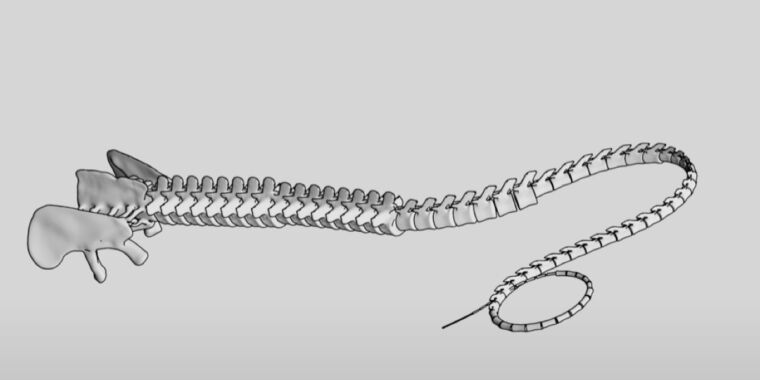No sonic boom: Scientists created a computer simulation showing the tail movement of Apatosaurus. Credit: Simone Conti.
Back in 1997, Microsoft’s then-chief technical officer, Nathan Myhrvold, made headlines when his computer simulations suggested that the enormous tails of sauropods—specifically Apatosaurus—could crack like a bullwhip and break the sound barrier, producing a sonic boom. Paleontologists deemed it an intriguing possibility, although several were skeptical. Now a fresh team of scientists has tackled the issue and built its own simulated model of an Apatosaurus tail. They found no evidence of a sonic boom, according to a new paper published in the journal Scientific Reports. In fact, the maximum speed possible in the new simulations was 10 times slower than the speed of sound in standard air.
While still at Microsoft in the 1990s, Myhrvold—a longtime dinosaur enthusiast—stumbled upon a book by zoologist Robert McNeill Alexander speculating about whether the tails of certain sauropods may have been used like a bullwhip to produce a loud noise as a defensive strategy, a mating call, or another purpose. The structure somewhat resembles a bullwhip in that each successive vertebra in the tail is roughly 6 percent smaller than its predecessor. It was already well-known in physics circles that the crack of a whip is due to a shock wave, or sonic boom, arising from the speed of the thin tip breaking through the sound barrier.
Myhrvold wanted to put that speculative suggestion to the test and struck up an email correspondence with paleontologist Philip Currie, now at the University of Alberta in Edmonton, Canada. (Fun fact: Currie was one of the inspirations for the Alan Grant character in Jurassic Park.) The two men analyzed fossils, developed computer models, and conducted several computer simulations to test the biomechanics of the sauropod’s tail. They also compared those simulations to the mechanics of whips.
They concluded that a side-to-side flick of the tail could send a wave of energy accelerating along the length of the appendage, gaining momentum so that the tip of the tail reached speeds of more than 750 miles per hour. The speed of sound changes depending on the medium and ambient conditions, like temperature, but it’s generally pegged at 740 mph in air at 0° C (32° F). Myhrvold and Currie noted in their published paper that only the last two to three inches of the tail would reach those supersonic speeds. They also suggested that the furthest part of the tail could have extended past the last vertebra by virtue of a piece of skin, tendon, or keratin—similar to the tips of whips made of cow or kangaroo skin, which are robust enough to withstand supersonic speeds.
Myhrvold gave an update on his research at a conference in 2002, reporting a maximum potential speed of 1,300 mph, which would have produced a sonic boom of around 200 decibels. Among other evidence: Some fossil specimens of sauropods have fused vertebrae in a key transition zone between the stiff base and the flexible section of the tail—much like a bullwhip eventually fails near the junction between the thick handle and the flexible leather portion.
Paleontologist Kenneth Carpenter was one of the most outspoken skeptics of the sonic boom hypothesis. “To be blunt, the computer simulations are another case of garbage in, garbage out,” he told The New York Times in 1995. Carpenter said he would be more receptive to the idea if a scale model could be built. It took nearly 20 years, but Myhrvold presented just such a model at the 2015 Society of Vertebrate Paleontology conference.








